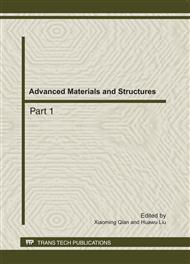p.994
p.1000
p.1004
p.1009
p.1014
p.1021
p.1025
p.1029
p.1035
Determination of Mechanics Properties of a Piezoelectric Material Using Indentation Method with a Cylindrical Indenter
Abstract:
The Finite Element Method (FEM) was used for axisymmetric indentation to investigate mechanics properties of piezoelectric solids (PZT-5H). Since piezoelectric materials are usually treated as transversely isotropic elastic materials, a simple linear relationship between indentation load P and indentation displacement h was presented under a cylindrical indenter. Three different cases (uncouple mechanical case, poled substrate-insulating indenter and poled substrate-conducting indenter) were taken into consideration to study indentation responses. The results showed that polarization could more easily damage the poled substrate than the uncoupled case. At the same displacement the highest indentation load existed in the poled/insulating case and the lowest one was in the uncoupled case because of the polarization influence. Electric potential distributions were given to study the direct piezoelectric effects and the electromechanical phenomena. In addition elastic modulus, contact stiffness, and piezoelectric strain constant were calculated directly through the use of the FEM. The determination of the poling direction is another use for the indentation technique, and the discussion of indentation size effect shows that a bigger indenter is followed by a larger indentation load.
Info:
Periodical:
Pages:
1014-1020
Citation:
Online since:
September 2011
Authors:
Price:
Сopyright:
© 2011 Trans Tech Publications Ltd. All Rights Reserved
Share:
Citation:


